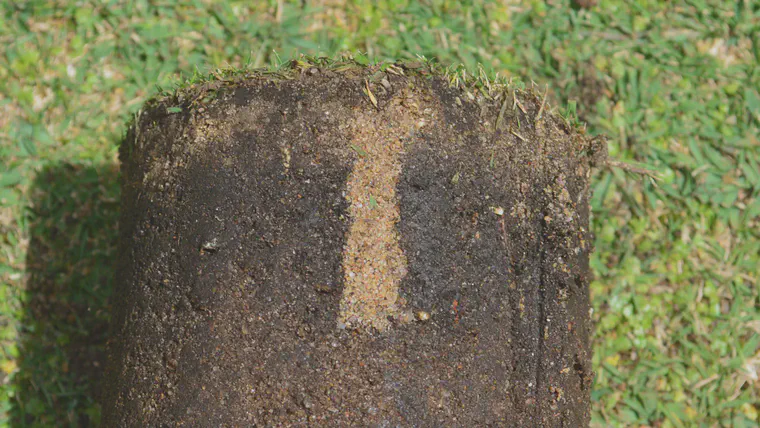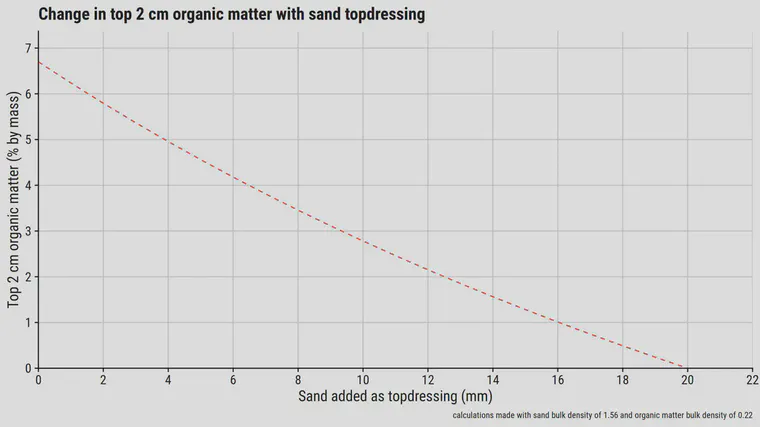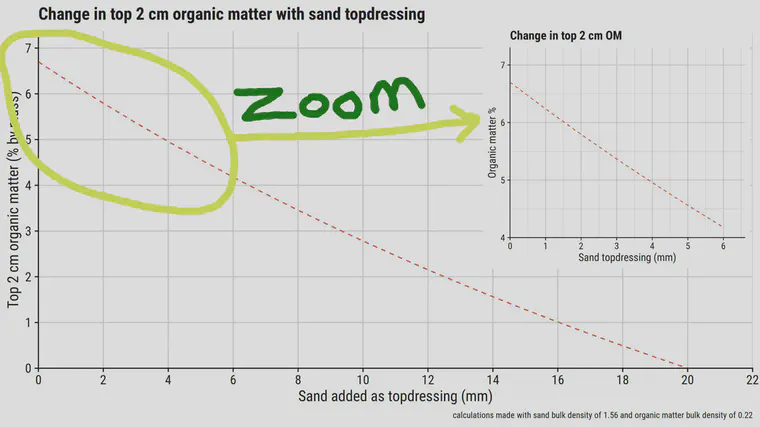Organic matter reduction by hollow-tines, solid-tines, and sand topdressing
This is an elaboration on, and an extension of, the calculations showing that hollow-tine cultivation, with removal of the cores, doesn’t reduce soil organic matter (OM) at all.
That’s not an intuitive result, because OM has obviously been removed from the rootzone. While the absolute amount of OM is lower after the cores are removed, the percentage OM in the remaining material is exactly the same as it was before the operation.

In the previous example, I worked through what happens with small diameter hollow-tines on close spacing, with 4 mm diameter cores, 3 x 3 cm hole spacing, and hole depth of 3 cm.
In this example I’m going to use slightly larger tines, at a more typical spacing and hole depth. I chose 12 mm diameter tines (~ 1/2 inch) on 5 cm x 5 cm spacing (2 inch x 2 inch) to a 7 cm depth (~ 3 inches). I calculate soil bulk density based on expected sand bulk density of 1.56 g/cm3 and OM bulk density of 0.22 g/cm3.
For the starting soil OM,1 it is at 3.4% in the top 7 cm, based on a gradient of:
- 6.7% OM from the surface to 2 cm (0.8 inches)
- 3.1% OM from 2 to 4 cm (0.8 to 1.6 inches)
- 2% OM from 4 to 6 cm (1.6 to 2.4 inches)
- 1.6% OM from 6 to 8 cm (2.4 to 3.2 inches)
Here’s what happens to the starting OM of 3.4% after these different scenarios.
Scenario 1a: hollow-tine cultivation (coring) with no sand added
When the cores are removed, that takes away 3,167 cm3/m2 of material and 139 g of OM. If I would take a sample of the remaining material, keeping the floor of the rootzone at 7 cm below original grade, the OM will remain the same as it was prior to the operation, at 3.4%.
This is because the original rootzone to 7 cm depth, in 1 m2, has a mass of 90,429 g. Removing 12 mm cores on 5 cm x 5 cm spacing takes away 4,092 g of material containing 139 g of OM. That’s 4.5% surface area affected with such a tine diameter and spacing.
The starting OM was 3,082 g in 90,429 g, or 3.4%.
The OM after the cores are removed is 2,943 g in 86,337 g, which is also 3.4%.
Scenario 1b: hollow-tine cultivation (coring) with no sand added, after holes collapse
If no sand is added to fill the holes, then I can expect them to collapse. When they do that, the floor of the rootzone will be 3.167 mm lower than it was prior to coring. Now when I take a soil sample to the 7 cm depth, I will get more of the 1.6% OM material that is in the original 6 to 8 cm depth of the rootzone.
With this scenario, letting core removal act as a lowering of the rootzone, the OM after cores are removed is 3.3%.
Scenario 2: solid-tine cultivation with no sand added
I’m assuming that these holes also collapse, so the rootzone floor remains at 7 cm without having removed any OM. Therefore, the OM remains at 3.4%.
Scenario 3: hollow-tine cultivation with sand added
The holes have a volume of 3,167 cm3/m2, and adding sand to fill those holes increases the mass of the rootzone without changing the depth. The OM after this operation is 3.2%.

Scenario 4: solid-tine cultivation with sand added
In this situation, the volume of the holes is 3,167 cm3/m2 but no material is removed, so adding the sand to fill the holes raises the floor of the rootzone by 3.167 mm. The OM after this operation is 3.3%.2
Scenario 5: no cultivation, sand topdressing at surface
It wouldn’t be prudent to topdress with 3.167 mm of sand all at once—that’s the amount that would be about 20 “light” topdressing applications. Assuming the soil OM accumulation and decomposition happen at the same rate during the time this amount of sand is applied at the surface, then the result is a 7 cm rootzone that now has 3.3% OM.
If you are like me, these numbers will surprise you in how small they are, and in how little change happens in the rootzone to a 7 cm depth when these operations are carried out. I’ve either made some errors in the calculations, or the removal amounts and sand topdressing amounts, when allocated over the entire 7 cm depth, lead to surprisingly small changes in the overall OM% of the rootzone.
Some major changes can happen if only the top 2 cm are considered. Here are a few additional scenarios.
Scenario 6: hollow-tine with sand added to 7 cm, result in top 2 cm
The top 2 cm has 6.7% OM to begin with, and the hollow-tine operation in scenario 3 above, after the holes are filled with sand, moves the OM in the top 2 cm down to 6.3%.
Scenario 7: solid-tine with sand added to 7 cm, result in top 2 cm
I’m not sure how to calculate this one. I’m imagining the 2 cm depth of the rootzone with holes in it, filled with sand, and it’s going to be identical to scenario 6 above in the numbers. Rather than removing the cores, the material has been displaced to somewhere other than the 0 to 2 cm depth, so after filling the holes, it’s going to be really close to 6.3%.

Scenario 8: no cultivation, sand topdressing, result in top 2 cm
With a starting OM of 6.7% in the 0 to 2 cm depth, adding 1 mm of topdressing sand at the surface brings the OM of the new top 2 cm to 6.2%. The next 1 mm of sand added to the top 2 cm leaves the OM at 5.8%.

These are typical values based on the measurements in the OM246 project. ↩︎
The OM to a 7 cm depth after solid-tine with sand added is 3.312%. This is lower than the OM if only hollow-tines are used to remove cores and then the holes collapse with no sand added. That operation produces an OM of 3.318%. ↩︎